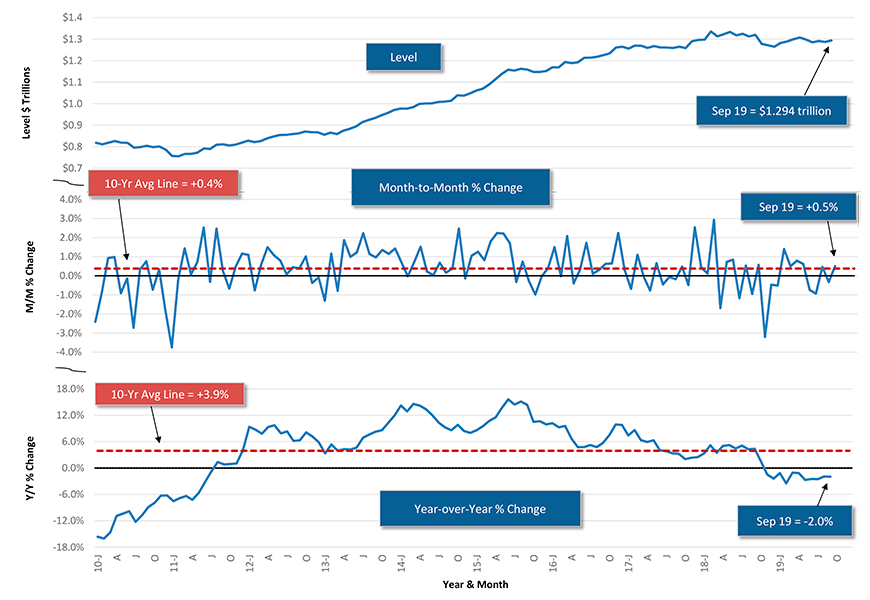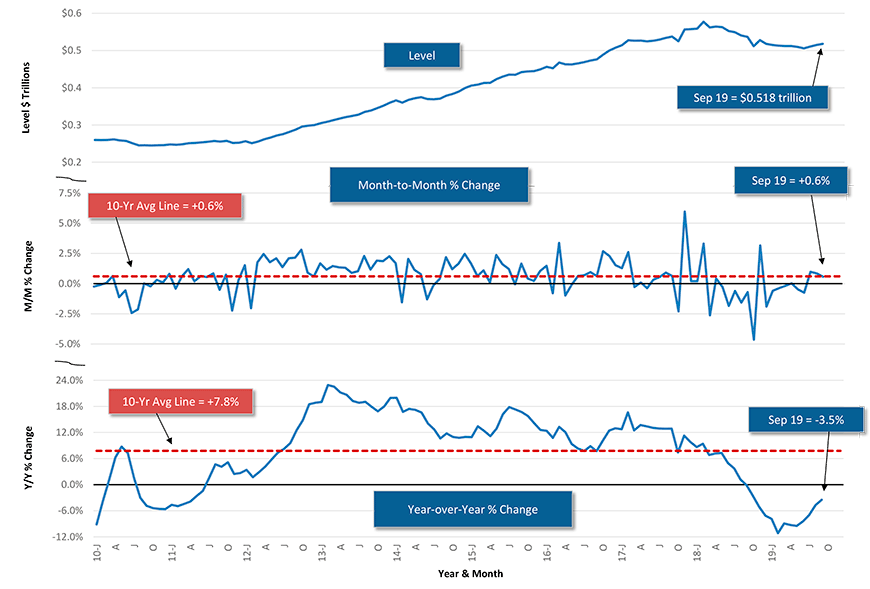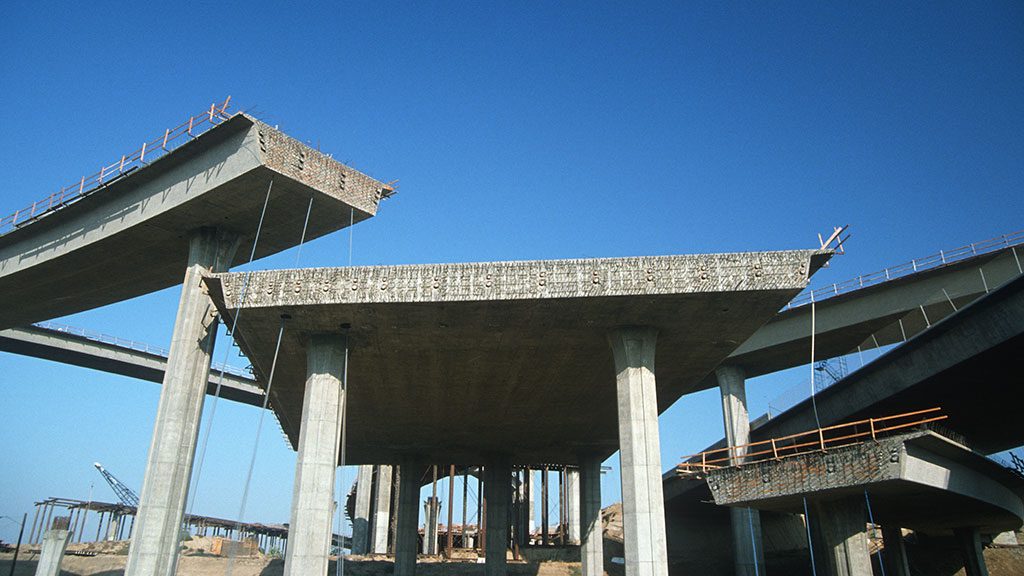In the latest month, total U.S. put-in-place construction spending, as measured by the Census Bureau, was -2.1% year to date (ytd ‒ i.e., Jan-Sept 2019 versus Jan-Sept 2018).

As for the total’s two major sub-components, residential (with a 40% share) was in decline, at -7.9% ytd, while nonresidential (with a 60% share) was modestly ahead, +2.2% ytd.
In concept, put-in-place construction figures are the summation of work-in-progress payments during any given month for all structures being built.
With respect to timing, they lag ‘starts’ statistics which are the summation of estimated final costs of all projects breaking ground in any given month.
A Flatlining in the Total Construction Curve
Graph 1 shows a flatlining in the level of total U.S. PIP construction dollars over the past two years, and maybe extending back three years. 2018 and 2019 have been only a little better than 2017.
September’s month-over-month (m/m) percent change in total PIP investment spending, at +0.5%, was both positive and a tiny bit above the +0.4% ten-year monthly average for the series.
Year-over-year (y/y), however, PIP’s ‘total’ performance was negative, at -2.0%, and well below the ten-year monthly y/y average of +3.9%. The y/y ‘total’ figure has been negative since the fall of 2018. This has been quite a departure from the solid improvement exhibited from 2012 through 2016.

Chart: ConstructConnect.
Residential PIP Construction Appears on the Mend
From the top portion of Graph 2, residential PIP capital spending has been mainly receding since the beginning of 2018, although there has been a gentle uptick in the last couple of months.
September’s residential m/m percent change (i.e., from the middle curve of Graph 2) of +0.6% was a match for the series’ ten-year monthly average. September’s residential y/y percent change (i.e., from the bottom curve of Graph 2), though, at -3.5%, was both negative and far weaker than the ten-year average for the y/y percent change of +7.8%.
Note, however, that the -3.5% y/y figure in September was much less severe than the -11.1% y/y result recorded in February of this year. The worst of the deterioration in residential PIP dollars, on a y/y basis, appears to be in the past. The dip in the y/y curve, which began in early 2017, is finally staging an encouraging reversal.
Furthermore, the shift towards lower interest rates once again should help the homebuilding sector with its turnaround.

Chart: ConstructConnect.
Nonresidential PIP Construction is Waffling
One would like to place an upward sloping trend line through the most recent years of the nonresidential PIP construction spending curve, but it may not be warranted.
September’s m/m change of +0.5% was a mild step up from the ten-year m/m average of +0.3%, but the latest month’s y/y performance of -0.9% was a far cry from the ten-year average of +2.1%.
Y/y nonresidential PIP construction spending has been hovering close to its ten-year average (+2.1%), with minimal upwards or downwards amplitude, since the spring of 2016.
An increase of +2.1% is a ‘current’ dollar figure. It doesn’t take inflation into account. Earlier in the cycle, tariff introductions on lumber, steel and aluminum boosted material costs. Over time, that effect has largely dissipated. Now, it’s labor costs that are boosting the price of construction work. A growth rate of +2.1% drops below zero in ‘constant’ dollars.
By the way, attention should be paid to the long-term average y/y percentage increases for residential versus nonresidential PIP construction spending. The former (+7.8%) has whipped the latter (+2.1%).

Chart: ConstructConnect.
Speed Up/Slow Down Table
Table 1 shines a spotlight on where, by type of structure, U.S. put-in-place construction spending has most recently been ‘speeding up’ or ‘slowing down’. A ‘speeding up’ or ‘slowing down’ determination is based on the percentage change performances of the PIP statistics in the latest three months over prior three months (annualized) compared with latest-12-months-over-prior-12-months.
A negative percent change that becomes less negative is judged to be an instance of ‘speeding up’. Appropriate check marks have been placed in the two final columns of Table 1.
Total construction dollars in September neither sped up nor slowed down. The latest-three-months’ result (-1.8%) was little altered from the latest-12-months’ result (-1.7%).
Residential dollar spending, however, speeded up considerably, moving from -7.2% for latest-12-months to +4.3% (annualized) for latest-three-months.
Nonresidential was a different story, downshifting from +2.2% to -5.7%.
Among nonresidential sub-categories, the ones displaying the best ytd (Q1-Q3 2019 vs Q1-Q3 2018) improvements have been ‘highway and street’, +10.4%; ‘conservation and development’, +10.0% (but it accounts for less than 1.0% of the ‘total’); and ‘lodging’ (+8.6%).
The sub-category that has fallen behind the most has been ‘commercial (retail, warehouse and restaurant construction)’, -13.1%.
Focusing on the two check-mark columns in Table 1, the sub-categories shifting most emphatically towards ‘speeding up’ in September were: ‘water supply’, +26.1 percentile points/ppts (e.g., from +1.0% to +27.1%); ‘conservation and development’, +15.2 ppts; ‘sewage and waste disposal’, +6.8 ppts; ‘communication’, +6.0 ppts; and ‘public safety’, +5.6 ppts.
The sub-categories with the largest course alterations towards ‘slowing down’ were: ‘highway and street’, -38.0 ppts; ‘lodging’, -20.6 ppts; ‘power’, -16.7 ppts; and ‘amusement and recreation’, -14.9 ppts.
Table 1: U.S. Put-in-place Construction Investment − September, 2019
Based on ‘current’ (i.e., not adjusted for inflation) $s, seasonally adjusted at annual rates (SAAR)
| Weighting of type-of-structure category (% of total $s) |
Year to date 2019/ Year to date 2018 |
Latest 12 mons vs. previous 12 mons | Latest 3 mons vs. previous 3 mons (annualized) |
Slowing Down 1 of 3 ‘Total’ categories / 7 of 16 sub-categories |
Speeding Up 1 of 3 ‘Total’ categories / 8 of 16 sub- categories |
||||||||
| Total Construction | 100.0% | -2.1% | -1.7% | -1.8% | |||||||||
| Total Residential | 40.0% | -7.9% | -7.2% | 4.3% | ✔ | ||||||||
| Total Nonresidential | 60.0% | 2.2% | 2.2% | -5.7% | ✔ | ||||||||
| Lodging | 2.6% | 8.6% | 9.3% | -11.3% | ✔ | ||||||||
| Office | 6.2% | 6.6% | 6.9% | 4.6% | ✔ | ||||||||
| Commercial (retail) | 6.3% | -13.1% | -9.5% | -6.4% | ✔ | ||||||||
| Health care | 3.4% | 3.5% | 1.9% | -3.5% | ✔ | ||||||||
| Educational | 7.5% | -1.8% | -1.8% | -1.8% | |||||||||
| Religious | 0.2% | -13.1% | -11.6% | -7.1% | ✔ | ||||||||
| Public safety | 0.8% | 5.7% | 7.1% | 12.7% | ✔ | ||||||||
| Amusement and recreation | 2.1% | 0.9% | 2.9% | -12.0% | ✔ | ||||||||
| Transportation | 4.3% | 7.0% | 7.0% | 1.7% | ✔ | ||||||||
| Communication | 1.8% | -5.3% | -3.7% | 2.3% | ✔ | ||||||||
| Power (electric; oil & gas) | 7.4% | 5.6% | 4.5% | -12.2% | ✔ | ||||||||
| Highway and street | 7.6% | 10.4% | 7.8% | -30.2% | ✔ | ||||||||
| Sewage and waste disposal | 2.1% | 7.0% | 4.5% | 11.3% | ✔ | ||||||||
| Water supply | 1.4% | 1.8% | 1.0% | 27.1% | ✔ | ||||||||
| Conservation and development | 0.7% | 10.0% | 9.3% | 24.5% | ✔ | ||||||||
| Manufacturing | 5.6% | 2.8% | 2.5% | 7.6% | ✔ |
In the final two columns, if there is no check mark in the cell, then the type-of-structure category has stayed within 1.0%, up or down.
A negative that becomes more negative is considered to be ‘slowing down’; if less negative, then ‘speeding up’.
Data source: Census Bureau / Table: ConstructConnect
Alex Carrick is Chief Economist for ConstructConnect. He has delivered presentations throughout North America on the U.S., Canadian and world construction outlooks. Mr. Carrick has been with the company since 1985. Links to his numerous articles are featured on Twitter @ConstructConnx, which has 50,000 followers.











Recent Comments
comments for this post are closed